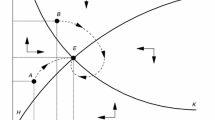Abstract
This paper integrates investments in health to a standard growth model where physical and human capital investments are the combined engines of growth. It shows the existence of two distinct health regimes separated by an “epidemiological transition.’’ The various patterns of this transition identified in the epidemiological literature can be mapped into the model. The model also leads to the important hypothesis that the epidemiological transition may induce an economy to switch to a modern growth regime.





Similar content being viewed by others
Notes
Life expectancy is included in the Human Development Index.
To simplify, it is assumed that all capital fully depreciates when used in the process of production.
As discussed below, small here means that: \( k_{t} < {\left( {\ifmmode\expandafter\bar\else\expandafter\=\fi{k}/B} \right)}^{{1/\alpha }} \) where \( B = A{\left[ {{\left( {1 - \alpha } \right)}/{\left( {3 + 1/\alpha } \right)}} \right]} \)
This paper ignores the positive contribution of a “good health’’ to labor productivity.
Each generation thus starts with the same health capital, although the model can be amended to allow for some health spillover from one generation to the next.
The findings of Fogel [6] support the hypothesis that the early decrease in mortality was closely associated with improved consumption and nutrition.
Other researchers have also argued that a mortality decline can foster the transition to a modern growth regime, although other mechanisms were considered (see, for instance, Kalemli-Ozcan [13]).
A poverty trap similar to that shown by Galor and Mayer-Foulkes (O. Galor and D. Mayer-Foulkes, unpublished paper on “Food for thought: basic needs and persistent educational inequality”, 2002).
Four when counting the transitional variant of the delayed model.
The assumption that health is the determining factor for longevity is consistent with empirical research.
See also Meltzer for Mexico [16]; for sub-Saharan Africa, S. Chakraborty, unpublished paper on “Endogenous lifetime and economic growth”, circulated at University of Oregon, 2002.
In Kalemli-Ozcan’s paper [13], parents make human capital investments in their children, but the mechanism is similar the one in this paper.
References
Acsadi G, Nemeskeri J (1970) History of human life span and mortality. Akademiai Kiado, Budapest
Bloom DE, Canning D (2000) The health and wealth of nations. Science 287:1207–1208
Case A (2001) Does money protect health? Evidence from South African pensions. Princeton University Center for Health and Well-Being, Princeton
Case A (2001) Health, income, and economic growth. ABCDE Conference, World Bank, May 2001
de la Croix D, Licandro O (1999) Life expectancy and endogenous growth. Econom Lett 65:255–263
Fogel R (1997) New findings on secular trends in nutrition and mortality: some implications for population theory.’ In: Rosenzweig M, Stark O (eds) The handbook of population and family economics, vol. 1A. North Holland, Amsterdam, pp
Fuchs VR (1982) Time preference and health: an exploratory study. In: Fuchs VR (ed) Economic aspects of health. University of Chicago Press, Chicago, pp 93–120
Galor O, Weil D (2000) Population, technology, and growth: from the Malthusian regime to the demographic transition. Am Econom Rev 90:806–828
Galor O, Weil D (1999) From Malthusian stagnation to modern growth. Am Econom Rev 89:150–154
Grossman M (1972) The demand for health: a theoretical and empirical investigation. Columbia University Press, New York
Haines M (1995) Disease and health through the ages. In: Simon JL (ed) The state of humanity. Blackwell, Oxford, pp 51–60
Hassan FA (1981) Demographic archaeology. Academic Press, New York
Kalemli-Ozcan S (2002) Does the mortality decline promote economic growth? J Econom Growth 7:411–439
Kremer M (1993) Population growth and technological change: one million B.C. to 1990. Quart J Econom 108:681–716
Lucas R (1988) On the mechanics of economic development. J Monetary Econom 22:3–42
Meltzer D (1992) Mortality decline, the demographic transition and economic growth. PhD Dissertation, University of Chicago
Mirman LJ (1971) Uncertainty and optimal consumption. Decisions Econometrica 39:140–146
Omran AR (1971) The epidemiologic transition. Milbank Memorial Fund Quarterly 49:509–538
Omran AR (1982) Epidemiologic transition. In: Ross JA (ed) International encyclopedia of population, vol. 1.The Free Press, London
Ram R, Schultz TW (1979) Life span, health, savings and productivity. Econom Dev Cultur Changes 13:399–421
Sala-i-Martin X (1997) I just ran two million regressions. Am Econom Rev 87:178–183
Van Zon A, Muysken J (2001) Health and endogenous growth. J Health Econ 20:169–185
Conflict of interest:
No information supplied.
Author information
Authors and Affiliations
Corresponding author
Rights and permissions
About this article
Cite this article
Morand, O.F. Economic growth, longevity and the epidemiological transition. HEPAC 5, 166–174 (2004). https://doi.org/10.1007/s10198-003-0219-9
Issue Date:
DOI: https://doi.org/10.1007/s10198-003-0219-9




